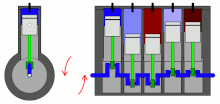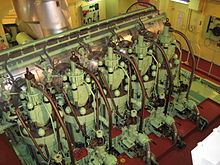Five-cylinder engine
The five-cylinder engine is a type of reciprocating - motors , in particular from internal combustion engines .
description
Types
When powered aircraft are radial engines used with five cylinders. With this type of engine, the number of cylinders is always uneven. The "Volkswagen" ( Porsche Type 12 ) developed by Ferdinand Porsche for Zündapp in 1931 also had a 5-cylinder radial engine. Another design was the 1938 Lancia 3Ro truck with an in-line five-cylinder diesel engine.
Five-cylinder in-line engines are found in motor vehicles, but also as smaller two-stroke diesel engines in ships. In 1974 Daimler-Benz AG presented the first passenger car diesel engine ( OM 617 ) with five cylinders in the Mercedes 240 D 3.0 , which had been developed from 1972 in the engineering office of Ferdinand Piëch , Ferdinand Porsche's grandson, in Stuttgart. In 1976 Audi NSU Auto Union AG presented the Audi 100 5E with a five-cylinder petrol engine , followed in 1978 by the Audi 100 5D with a diesel engine.
In 2001, Honda developed a V5 engine for use in motorcycle racing. The RC211V equipped with the V5 was used from 2001 to 2006.
Application as an in-line engine
The Mercedes-Benz OM617 diesel engine ("oil engine" type 617) developed in the early 1970s was produced by Daimler-Benz up to the turn of the millennium, where it was used across all classes and sold a total of several million times. However, due to unfavorable vibrations from 4400 rpm due to the free mass moments of the 2nd order, it was initially not used as a gasoline engine.
That changed with the Audi 100 5E presented in 1976. Audi NSU had managed to get the vibration problem under control; the engines were pleasingly long-lived by the standards of the time and had a favorable power and torque curve. From 1980 the Urquattro went into series production, which was exclusively equipped with five-cylinder engines. The quattro all-wheel drive brought Audi two rally world championship titles and also made the five-cylinder gasoline engine popular, which made this engine concept more interesting again for other manufacturers: From 1997 to 2005, Volkswagen produced five-cylinder VR engines that were used in the VW Golf IV , VW Bora , VW New Beetle and VW Passat B5 as well as in the Seat Toledo II were used.
In addition, various manufacturers (including Volvo, Fiat and Ford) used five-cylinder engines, as they are shorter than in-line six-cylinder engines and are therefore also suitable for transverse installation. Volvo used petrol and diesel five-cylinder (in the 850, C30, S / V40, V50, S / V 60, S / V / C70, S80, XC60, XC90). Volkswagen used five-cylinder petrol engines and diesel with 2.4 l or 2.5 l displacement in the T4 , also with exhaust gas turbochargers ; also in the T5 , but there only with 2.5 l displacement.
Fiat had a diesel five-cylinder with 2.4 l displacement, which was installed in various models of the group with different power levels (Alfa 156, Alfa 159, Alfa 166, Alfa Brera, Alfa Spider; Fiat Croma 194, Lancia Kappa, Lancia Thesis, Lancia Lybra ). Fiat also had five-cylinder 2.0-l and 2.4-l petrol engines in its range (Fiat Bravo 182 HGT, Fiat Marea [also as Turbo in Brazil], Fiat Coupé [also as Turbo], Fiat Stilo; Lancia) Kappa [also as Turbo], Lancia Thesis [also as Turbo], Lancia Lybra).
Ford built a Volvo turbo five-cylinder into the Focus ST , Focus RS, Kuga, Mondeo and S-Max. These engines have been replaced by the new four-cylinder EcoBoost engines. The only five-cylinder for the European market is currently a 3.2-liter turbodiesel in the Ford Ranger .
Audi uses five-cylinder engines in the TT RS , RS Q3 and RS3 . Mercedes retired its five-cylinder engines between 2003 and 2005.
Smoothness
Five-cylinder in-line engines stand between four- and six -cylinder in-line engines when it comes to smooth running and development characteristics . The smoothness is naturally better than with a four-cylinder , but worse than with a six-cylinder. The free moments of inertia of the first order can be reduced with a balancer shaft rotating in the opposite direction to the crankshaft ; Due to the technical complexity, the second order moments are not compensated for. The engine noise of five-cylinder in-line engines has a characteristic sound.
literature
- Jan Drummans: The car and its technology. 1st edition, Motorbuchverlag, Stuttgart, 1992, ISBN 3-613-01288-X
- Peter Gerigk, Detlev Bruhn, Dietmar Danner: Automotive engineering. 3rd edition, Westermann Schulbuchverlag GmbH, Braunschweig, 2000, ISBN 3-14-221500-X
- Max Bohner, Richard Fischer, Rolf Gscheidle: Expertise in automotive technology. 27th edition, Verlag Europa-Lehrmittel, Haan-Gruiten, 2001, ISBN 3-8085-2067-1

